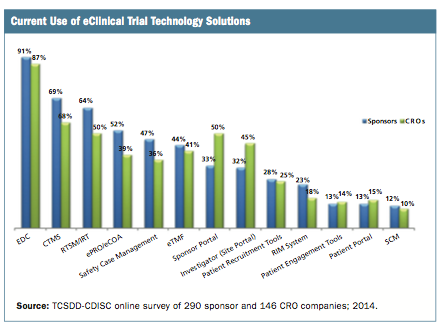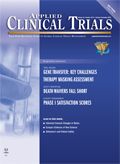A New Look at the Arsenal of Tech Solutions
Applied Clinical Trials
Survey provides new benchmarks on e-solutions adoption, but actual impact data remains elusive.
One can’t help but marvel at the number of clinical trial technology solutions providers exhibiting at major conferences like the Drug Information Association (DIA) annual meeting or the Disruptive Innovations conference. The advent of new and potentially lower-cost technologies improved access to capital, and better access to scientific and operating data has fueled a proliferation of vendors
Kenneth A. Getz

and solutions categories. These categories include mature solutions where substantial vendor consolidation has occurred, as well as nascent solutions that have attracted a vast collective of players.
To name but a few of the solutions categories: document exchange portals; electronic data capture (EDC); electronic case report forms (eCRFs); electronic patient-reported outcomes (ePRO); ePRO/electronic clinical outcomes assessments (eCOA); electronic trial master files (eTMFs); site-oriented project management technologies; randomization and trial supply management/interactive response technologies (RTSM/IRT); structured content management (SCM); and regulatory information management (RIM). Taken all together, according to a recent analyst report, the clinical trial technology sector will generate total global sales of $5 billion by 2018, nearly a 14% five-year annual growth rate.
Despite the expanding depth and breadth of eClinical technology solutions during the past two decades, the drug development enterprise continues to experience long cycle times, more complex protocols, and high levels of inefficiency. The average clinical phase duration is 6.8 years, a 15% increase over levels observed 10 years ago. Only 11.3% of drugs that enter clinical testing will be approved in the U.S. and Europe, half the success rate observed 15 years ago. In addition, the total capitalized cost to develop a single drug now exceeds $2.5 billion-nearly a 9% annual increase over 2003 levels when adjusted for inflation.
Given rising cost and high levels of risk and inefficiency, pressure on sponsors and contract research organizations (CROs) to adopt technology solutions that promise to streamline processes and accelerate management decision-making have intensified. Regulatory agency support of technology solutions adoption to improve efficiency has also increased. But there have been few reports published in the last decade that monitor and inform industry professionals on the usage and adoption of eClinical technology solutions. It seems that as the breadth and depth of the arsenal of technology solutions has expanded, our ability to monitor usage and impact has diminished.
In mid-2014, the Tufts Center for the Study of Drug Development (Tufts CSDD) collaborated with the Clinical Data Interchange Standards Consortium (CDISC) and 10 biopharmaceutical companies, CROs, and eClinical technology vendors to develop an online survey to gather updated benchmark data on technology solution usage. This working group of participating companies had planned to gather study performance data to evaluate the impact of various solutions. That ambitious plan, however, was quickly aborted-a very telling sign about the ways that technology solutions are used and managed within organizations. More about that later.
Updated usage benchmarks
More than 550 companies completed the online survey in late 2014. Of that total, 290 sponsor companies and 146 CROs responded, representing a broad mix of large global, mid-sized, and smaller companies. Overall, the rate of adoption of nearly all technology solutions was higher among sponsor companies than CROs, with only two exceptions (see chart).

The top five most-used technology solutions are EDC, CTMS, RTSM/IRT, and ePRO/eCOA. More than 90% of sponsors and 87% of CROs report that they are currently using EDC; two-thirds of sponsors and nearly 60% of CROs report regularly using CTMS. Usage varied by study phase with Phase III studies receiving the highest usage rates of these four solutions categories.
Four out of 10 sponsors and CROs report that they are now routinely using eTMF and safety case management systems. As expected, a relatively small percentage of sponsors and CROs report using newer solutions regularly, such as RIM, patient portals, and SCM.
The cost of implementing technology solutions remains the primary barrier to adoption. A similar result was shown in a 2007 survey of EDC adoption. A strong majority, 80% of sponsor companies and 70% of CROs, cited the investment required as the top constraint. Approximately half of sponsors and CROs cited having insufficient time to evaluate new systems and the challenge of having to maintain old and new systems simultaneously as major barriers to adoption. Nearly 60% of sponsors and CROs noted that, in many cases, their current processes and systems were performing adequately and there was limited incentive or a reasonable value proposition to adopt something new.
The companies responding to our survey showed mixed experience and perceptions regarding the integration of eClinical systems. Nearly one in four (37%) sponsor and CRO companies reported that they have already integrated some of their systems or are currently working on integrating systems. About one-third (29%) of companies were uncertain about what integration steps had been implemented or were underway. Nearly one-third of sponsors (31%) and four out of 10 (37%) CROs report having integrated both front-end and back-end systems, whereas one-in-five (21%) have purchased prebuilt integrated systems.
Looking over a short term time horizon, sponsors and CROs report concerns about accommodating a number of new technology developments. Two areas in particular were the most cited: 88% of companies said that they are looking to accommodate patients’ own devices (e.g., smart phones and other mobile devices) in clinical trials. And 80% of respondents noted that they are anticipating and evaluating the use of validated wearable devices and the collection of real-time patient data. A small number of companies also acknowledged the growing importance of management data to support predictive analytics.
Benchmarks, but not impact
The results of this important study provide useful new benchmarks on technology solutions adoption. Sponsor and CRO companies are currently using EDC, CTMS, RTSM/IRT, and ePRO/eCOA extensively and actively. These findings are not surprising given that EDC and CTMS are relatively mature systems categories, and they have become widely viewed as common solutions. Use of RTSM/IRT within clinical supply and logistics functions is also relatively high and speaks to the growing need for more sophisticated controls as trials have become increasingly dispersed. Use of ePRO tools is also relatively high for registration and post-marketing studies. Use of investigator and patient portals, however, are only beginning to resonate.
Technology solutions integration appears to be occurring on a more limited basis than expected. Many factors are likely constraining integration efforts, including high costs, implementation and compatibility challenges, and insufficient use of data standards.
The difficulty in gathering data characterizing the impact of technology solutions on performance, efficiency, and drug development economics is disappointing. Our working group struggled on so many levels to derive a methodology that would cleanly and reasonably measure impact. The group concluded that there is too much noise from disparate practices to be mitigated. And most participating companies can neither access nor collect a sufficient amount of performance data to make this exercise feasible.
The real-world practice of technology solutions usage within and between companies makes it particularly challenging to gather performance and management metrics. Company use of technology solutions is typically inconsistent as organizations juggle the use of legacy, new, and pilot solutions simultaneously. Clinical teams and contract service providers also play a role in dictating the technology solutions that will be used on a given study.
There is no doubt that next year, and in the years thereafter, we will continue to see a proliferation of technology solutions targeting specific areas within the drug development continuum of activity. In addition to monitoring and updating adoption trends, hopefully, we will ultimately find ways to reasonably and credibly quantify return on technology solution investment.
Kenneth A. Getz, MBA, is the Director of Sponsored Research at the Tufts CSDD and Chairman of CISCRP, both in Boston, MA, e-mail: kenneth.getz@tufts.edu.
